Intermediate Entity-based Sparse Interpretable Representation Learning
Paper and Code
Dec 03, 2022



Interpretable entity representations (IERs) are sparse embeddings that are "human-readable" in that dimensions correspond to fine-grained entity types and values are predicted probabilities that a given entity is of the corresponding type. These methods perform well in zero-shot and low supervision settings. Compared to standard dense neural embeddings, such interpretable representations may permit analysis and debugging. However, while fine-tuning sparse, interpretable representations improves accuracy on downstream tasks, it destroys the semantics of the dimensions which were enforced in pre-training. Can we maintain the interpretable semantics afforded by IERs while improving predictive performance on downstream tasks? Toward this end, we propose Intermediate enTity-based Sparse Interpretable Representation Learning (ItsIRL). ItsIRL realizes improved performance over prior IERs on biomedical tasks, while maintaining "interpretability" generally and their ability to support model debugging specifically. The latter is enabled in part by the ability to perform "counterfactual" fine-grained entity type manipulation, which we explore in this work. Finally, we propose a method to construct entity type based class prototypes for revealing global semantic properties of classes learned by our model.
 Add to Chrome
Add to Chrome Add to Firefox
Add to Firefox Add to Edge
Add to Edge